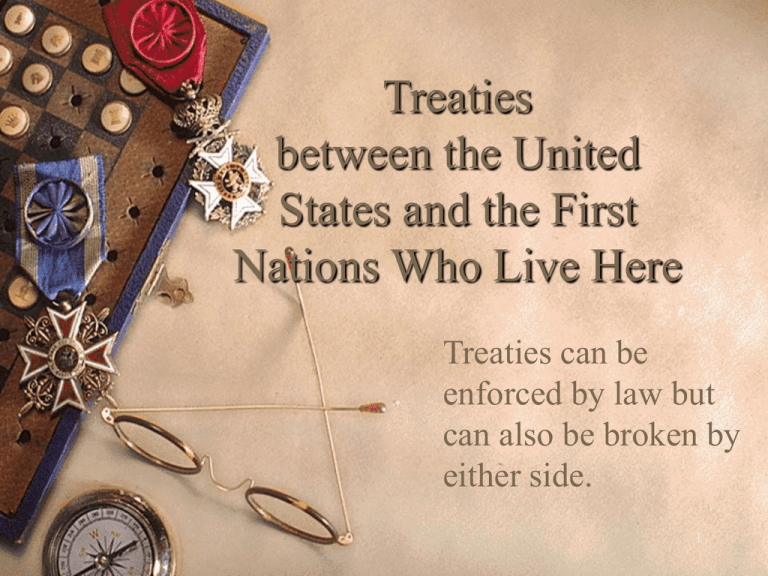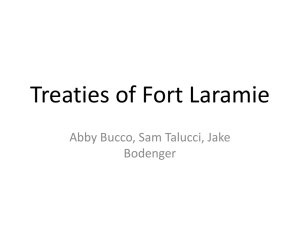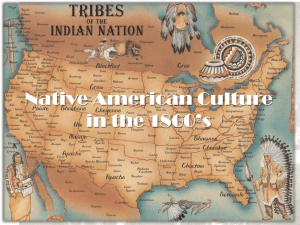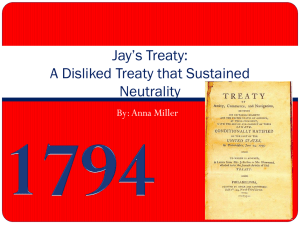Treaties
advertisement

Treaties between the United States and the First Nations Who Live Here Treaties can be enforced by law but can also be broken by either side. 1 Treaties – What are they? All Americans today live on land that was once Indian land. Treaties transferred the land from the Indian tribes to United States control. President George Washington signed the first treaties with Indian tribes. – The bargains were between equal groups. – The U.S. was a sovereign nation and each Indian tribe was a sovereign nation. – The first treaties were of peace. – Both sides were military equals. • http://stories.washingtonhistory.org/treatytrail/teaching/pdfs/ whatisatreaty_UT.pdf 2 The Indian Removal Act of 1830 Signed by President Jackson. States were eager to gain access to Indian lands. Tens of thousands of Indians emigrated to the lands to the west. Many Indians were removed forcibly against their will. 3 Indian Removal Act of 1830 4 Treaties Indians thought treaties were legal immediately upon signing, but they weren’t. Congress had to ratify the treaties first. Treaties that were signed between the U.S. and Montana’s tribes. – Treaty of Fort Laramie • signed September 17, 1851 – Flathead Treaty • signed July 16, 1855 • Ratified March 8, 1859 – Blackfoot Peace Treaty • signed October 17, 1855 • Became law in 1856 5 Treaty of Fort Laramie (1851) Established territorial boundaries for tribes east of the Continental Divide in Montana. Was not attended by the Blackfeet, but it did define their territory. No land was ceded (surrendered) to the U.S. from Montana tribes. U.S. promised control of the Great Plains to the Indians “as long as the river flows and the eagle flies.” Indians guaranteed safe passage for settlers on the Oregon Trail. Provided a brief period of peace. 6 Fort Laramie Treaty of 1851 – Lands Defined 7 Isaac Stevens 1st governor of newly formed Washington Territory. – Called treaty councils and invited tribes, hoping to place them on reservations. – Indians thought they were attending peace councils, not councils which would put them on reservations. From 1855-56, Stevens formed several treaties between the U.S.and Indians in territory that is now Washington, Oregon, Idaho, and Montana. 1855 Montana Treaties under Governor Stevens: – July 9th – 16th : Flathead Council (Treaty of Hell Gate) – October 16th – 17th : Blackfoot Council (Lame Bull Treaty) 8 The Medicine Creek Treaty In 1854, before heading to the area that is now Montana, Governor Stevens held a treaty council in the area that is now Washington state. – Medicine Creek Treaty • December 26, 1854 • Affected Coastal and Plateau tribes – To view a short video on the Native American perspective of that historic incident, click on the first image below and wait for the site to load… • Once you’re at the site, follow Steps 1 and 2 below. • Step 1 - • Step 2 - Choose the option circled in red below. • Step 3 – Click on the back button on your browser to return to this slide. Run time: 2 ½ minutes 9 Hellgate Treaty (1855) Also known as the Flathead Treaty Three tribes ceded large tracts of land to the U.S. – Gave up 12 million acres of ancestral land – “Received” 1.25 million acres on Flathead Reservation. Established the Flathead Reservation in its present location for the Pend d’Oreille and Kootenai. Provided a conditional reservation in the Bitterroot Valley for the Salish – In 1872, this land was withdrawn from consideration; the Salish were later forcibly removed to the Flathead Reservation. 10 The Site of the Hellgate Treaty – a present day state park Council Grove State Park, near Missoula 11 Blackfoot Peace Treaty (1855) Also known as: – – – – the Lame Bull Treaty the Judith River Treaty Fort Benton Council The Great Peace Council Gathering was dominated by bands of Blackfeet and their allies, the Gros Ventre. Thousands of people from the western tribes attended (Salish, Kootenai, Pend d’Oreille, and Nez Perce). Assiniboine sent messages, but did not attend. Crow did not attend; had not been notified. 12 Site of the Blackfoot Peace Treaty © Regional Learning Project 13 The Great Peace Council – 1855 – Blackfoot Peace Treaty 1855 Treaty Gathering – At the mouth of the Judith River – Thousands of people from 3 different groups • Officials representing U.S. government. • Tribal members from east of the Continental Divide. • Tribal members from west of the Continental Divide. – Promised peaceful relations with tribes who signed. – Created shared buffalo hunting areas in portions of Blackfoot territory east of the Rocky Mountains. – Both past generations and our current society have been affected. 14 The Great Peace Council of 1855 – Blackfoot Peace Treaty Terms of a treaty are negotiated (agreed upon) between the parties to the treaty. As a class, we will negotiate for something we want to protect. Before we begin negotiating, we will work with maps and terms to help us understand what the Great Peace Council meant to the Indians and to the United States officials who participated in it. 15 Knowing Montana’s Rivers Now we will pause our slide show to use Google Earth. We will “fly to” these life-sustaining Montana rivers that were so important to the Indian way of life. Choose two or more of the following rivers to “fly to.” [Make note of the river names and switch to Google Earth now.] – – – – – – Missouri Musselshell Milk Marias Yellowstone Clark Fork 16 Montana Rivers Map Exercise Now that we’ve seen an aerial view of the rivers, we’ll proceed to locate them on the map. Use a blue pencil or marker and USGS map to highlight the course of: – – – – – – Missouri and its three separate forks Musselshell Milk Marias Yellowstone Clark Fork 17 Patterns of River Systems In which direction do these rivers flow? Are the rivers tributaries to larger rivers? What body of water do these rivers end up spilling into eventually? Investigate the following vocabulary terms: Continental Divide – Headwaters (Click on the button to see a map .) • Small creeks at the uppermost end of a stream system, often found in the mountains, that contribute to larger creeks and rivers. 49th Parallel • (Click on the button to see one of the locations of the 49th Parallel North, which forms part of the boundary between the United States and Canada.) 18 Map of the Great Divide 19 The 49th Parallel at Waterton Lake Image licensed under Wikimedia 20 Historical Map Comparison Note the pattern of the river systems on the map you colored. Recognize that pattern so that you can orient yourself when you view an historic map. Examine the 1857 Stevens map showing the Indian Nations and Tribes in the area that would become Montana. 21 1857 Map 22 1857 Stevens Map Locate the rivers you identified on USGS map. Locate “common hunting grounds” Locate forts and passes. Locate boundaries drawn to show reservation lands on the west side. What other things can you learn from this map? 23 Use Maps to Find Locations Write down any six of the following terms and see if you can locate them on one or both maps (Stevens and USGS. Continental Divide Fort Benton Washington Territory Nebraska Territory Fort Union Missouri River Milk River Judith River Rocky Mountains Yellow Stone River 50th Parallel 106 ° longitude Bear Paw Mountains Teton River Meldrum’s Fort Muscle Shell River Fort Owen Big Horn River Arrow Creek Three Buttes Three Forks Common Hunting Ground Belly River Cypress Hills Chief Mountain Smith’s River Bitter Root Valley 24 Reflection Questions Which features were you able to find only on the historic map? Which features were you able to find on both maps? Which features were you unable to find at all? From your observations, which map features have changed and which have not in the past 150 years? 25 The Circle is Sacred to Indian Culture Power of the world works in circles Circle is found in nature. Traditional Indian activities conducted within the circle. 26 Breaking the Sacred Circle Black Elk, a respected Oglala Sioux, was 12 when he participated in the Battle of the Little Big Horn. He observed that: – the Sacred Circle was being broken, and the American Indian was being placed in boxes. – Indians were restricted so much that they could not carry on traditions they had practiced for generations. From The Treaty Trail lesson plan, Washington State History Museum 27 Your Sacred Space: An Activity Complete the following as homework: – Create a floor plan of a place you consider uniquely yours and sacred. This is typically a bedroom, but could also be a favorite, private place that you like to go to play or think, or it could be a church or a place of prayer. – Be as detailed as possible and list or draw all the items contained in this area. Think about why your sacred space is important to you, and how you’d feel if it was taken away. Remember to bring back your floor plan for the next day’s activity. Click button now to view floor plan. Floor Plan From The Treaty Trail lesson plan, Washington State History Museum 28 Floor Plan Worksheet 29 Treaty Negotiations - Activity Bring your sacred space floor plan with you. Gather with your assigned group A, B, C, or D as instructed by your teacher. If you forgot your sacred space floor plan, you will be placed in Group C or Group D. Read the rules of Negotiation on the following slide. From The Treaty Trail lesson plan, Washington State History Museum 30 Rules of Negotiation Groups A, B, C, and D From The Treaty Trail lesson plan, Washington State History Museum Return to Negotiation Preparations Slide Return to Negotiation Guidelines Slide 31 Treaty Negotiation Preparations Before you enter the negotiations, complete the worksheet. There are no wrong or right answers, but doing your best thinking will help with your upcoming negotiation with your pretend brother or sister or your parent or child. Click to link to your worksheet. – – – – Siblings Group A Siblings Group B Sons and Daughters Parents Group D Back to Rules Group C To Slide 37 From The Treaty Trail lesson plan, Washington State History Museum 32 Siblings Group A 33 Siblings Group B 34 Sons & Daughters Group C 35 Parents Group D 36 Negotiation Guidelines Feel free to negotiate based on what is best for you, but abide by handouts. Teacher is ultimate authority in disputes. Teacher always sides with Group D and Group B, even if their tactics are unfair. Students have 15 minutes to negotiate for your sacred space. Back to Rules Teacher avoids interfering. Record treaty settlements on the handout From The Treaty Trail lesson plan, Washington State History Museum 37 Treaty Settlement Worksheet 38 Treaty Negotiations Summary For homework, journal about your feelings during treaty negotiations. Class discussion about treaty negotiations. – Read examples from A-B negotiations and CD negotiations. – Discuss how sibling-sibling negotiations differed from parent-child negotiations. From The Treaty Trail lesson plan, Washington State History Museum 39 Differences in Negotiations Primary differences between early treaties and later treaties were identical to your experiences. – English colonial treaties with Indian tribes. – Group A – represented English colonial interests. – Group B – represented Northeast tribes. – U.S. Government treaties with tribes. – Group C – represented United States interests. – Group D – represented Northwest tribes. From The Treaty Trail lesson plan, Washington State History Museum 40 How Successful Were the Indians? Look at the map on the next page. The large colored portions of the map indicate the lands that the Indian tribes negotiated in the treaty in 1855. The small reservations that are shown on the map indicate the lands that the tribes hold today. How successful were the tribes in keeping the land that had been agreed upon in the treaty? 41 Tribal Territories Map © Regional Learning Project 42 Whose Worldview? European Americans or Native Americans? Age-old connections to the land. Generations of ancestors had lived there. Covenant with the Creator Homeland had been left far behind. Thought of the land as something to be used rather than something that sustained them. Humans are superior – Care for plants and – Little concern for animals in homeland – Creator would care for them in return. plants and animals. – No interdependence with creation. 43









